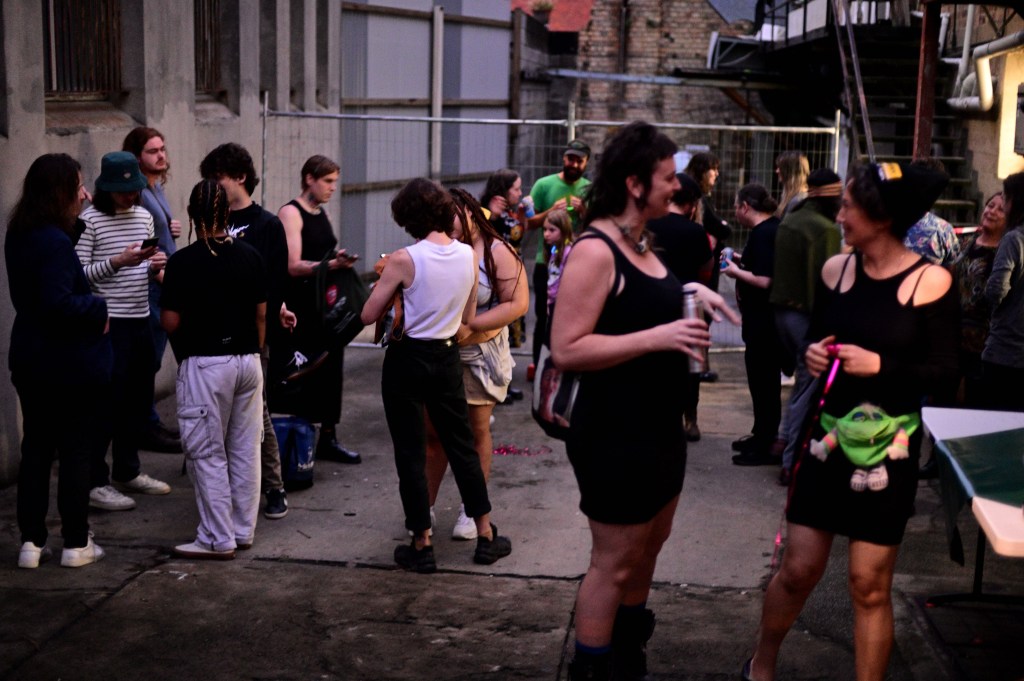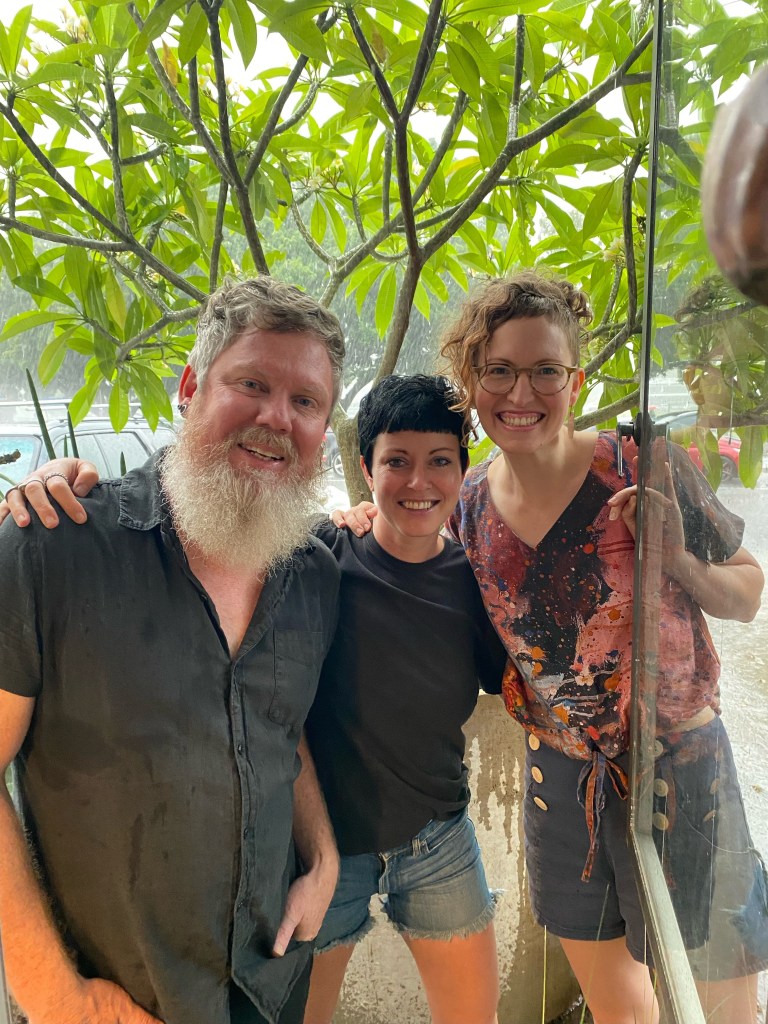Meanjin/Brisbane is proving fertile ground for the arts, with the late April and early May launches of experimental art space, Cyber Bunker, and artist studios, Here Space respectively. Both grassroots initiatives are run by artists who intend on enriching the cultural landscape, with greater representation of LGBITQA+, linguistically diverse and neurodiverse practitioners.
They are the most recent examples of artists pooling their resources and diversifying their skills to create facilities that meet the needs of their colleagues. Initiated and run independent of government, they provide a range of services to communities that are presently underserved by funded organisations.
Sustainable commerce meets physical and emotional comfort
Co-founder of Here Space, emerging artist Michelle Vine, says, ‘To have a space that’s owned by queer, disabled, neurodivergent and trans owners – that is pretty [unusual] in itself.
‘We went and looked at most places around Brisbane to see if we could find a suitable studio. Even if I could afford it, I couldn’t find any that met my accessibility needs as a disabled artist. I use a cane and a wheelie walker.
‘I guess that I found that shocking,’ says Vine.
Her life partner and co-founder of Here Space, narrative artist and installation designer Perrin Ellis, adds, ‘There is a certain amount of romance about the … rough and tumble industrial space that is your artist studio.
‘After a certain point [you ask] why be uncomfortable in the place you make work?’ (Vine adds, ‘And unsafe.’)
After months of searching, the couple came across some ‘well-used industrial and commercial premises’ situated on a leafy street with residential housing. The alterations they undertook, with the paid assistance of some artists, included grinding the floor, painting the walls and building partitions. Demonstrating considerable acumen in financial management, this enterprise was entirely self-funded.
‘We haven’t set it up as a not-for-profit yet, purely because of the speed with which we needed to set [the space] up,’ Vine says.
‘Any profits we’re making, we want to put it back into two things, which is improving the space, but also offering equity scholarships for people who don’t have access to studios.
‘We’re going to be offering a studio space that’s heavily subsidised for a First Nations, disabled and/or LGBITQA+ member,’ says Vine.
Vine is the Deputy Chair of the Board of National Association of Visual Arts (NAVA) and an Equity, Diversity and Inclusion (EDI) Coordinator at the Queensland College of Art and Design (QCAD). Her multidisciplinary arts practice investigates disability and wellness, through creating tactile participatory experiences.
While giving careful consideration to the dynamics of personalities and creative practices when selecting artists, Here Space’s first 10 available spaces were filled within 48 hours of a call-out. Among the current studio members are Canadian artist and designer, Janice Rieger, and queer Brisbane-born sculptor with Australian, Hongkonger and Chinese heritage, Mark du Potiers.
Membership includes access to a workshop, kitchen, lounge/meeting area and a project space. Although a group exhibition was staged in the latter as part of the opening weekend celebrations, its primary purpose is for testing artwork by studio members.
‘Running a gallery – that’s not on our radar,’ Ellis says. ‘It’s about what we need for our practice.’
Ellis also teaches at QCAD in design, and notes that in their home country – the US – lecturers are typically provided with studio space by universities.
Space for showcasing new talent
A fortnight prior to Here Space’s launch, Cyber Bunker staged its inaugural event on Gipps Street in the Fortitude Valley. Cyber Bunker founder and interactive new media artist, Tara Pattenden, tells ArtsHub that it was a night of many firsts.
‘Digicarrie – she played her first noise gig. She makes guitar pedals and stuff. One of the poets – it was [their] first gig as well.’
In addition to non-binary poet and writer Rae White, the evening featured the talents of musician Yvette Ofa Agapow.

Pattenden’s associate, sound artist and writer Nicola Morton, describes giving ‘a platform to women, trans and non-binary artists’ as ‘part of the mission’. Having worked in Western Sydney, ‘where there’s support from government and community institutions for diversity,’ Morton felt it was ‘a bit lacking’ in Brisbane.
Morton is a woman with Chinese Malaysian heritage, and adds, ‘I know it’s hard, just from my own experience. I want to make it easier for other people with that same background.’
Despite what she describes as an abundance of available commercial space in the Fortitude Valley, Pattenden recounts the comparative difficulty faced by artists attempting to secure space in Brisbane.
‘I feel like there are so many [more] venues overseas… [where] they’ll have a place for artists to stay at the back,’ Pattenden says.
‘[Cyber Bunker] came to be because the physical space became available – [it] looked like this was too good an opportunity.’
Cyber Bunker has also since staged a screening of a documentary by Indonesian collective Jogja Noise Bombing, who Morton met while on an Asialink residency in 2011. Among the scheduled events is an exhibition by evocative emerging installation artist, Rin Charlton.
Running costs for the initiative, including affording fees to contributing artists, are recuperated through ticket sales. In acknowledgement of the rising cost of living and housing crisis in South-East Queensland, Cyber Bunker invites audiences to nominate prices they can afford.
‘We’re not trying to make a profit,’ Pattenden says.
‘We put the money back into the space and the artists – we want to be really transparent.’
A self-made legacy
With the lifespans of artist run initiatives (ARIs) being purportedly short, and three out of four businesses in Australia failing within five years, the facilities run by artists in Brisbane demonstrate considerable resilience.
Entering its fifth year, Land Street Gallery + Studio was founded by QCAD fine arts graduate, Jack Fitz-Walter. A residency program operates on the premises between January and March, with an exhibition program running for the remainder of the year. According to Fitz-Walter, it operates with a ‘multifaceted’ business model, which incorporates user-pays, open call and commercial. The Gallery is dedicated to getting ‘relevant and contemporary’ artwork produced by ‘committed and consistent’ artists ‘into a wider sphere’, he says.
KEPK also opened in 2020. According to Joseph Burgess, it’s designed to provide artists with an alternative to the venues run by ‘council and other entities’, which enables greater ‘freedom of expression’. With Burgess, who performs under the name “Unregistered Builder”, at the helm, a team of artists renovated an industrial warehouse in Yeerongpilly into artist studios, an imaging studio, an art gallery and an events space. Unhindered by noise restrictions, they “intersect” between the visual arts and music scenes ‘more heavily than any of the other galleries’. Burgess and his life partner, ceramicist Mélina Celik, took over the lease in 2022.
Pretty vacant
Catalysed by a common desire for what ceramist and architect Laura Pascoe describes as, ‘affordable studio space in West End’, Vacant Assembly was formed in 2018. Its other two multidisciplinary co-founders are furniture maker, photographer and social worker, Sarah Seminutin, and abstract artist and community worker, Sam Eyles. The trio recognised the industrial warehouse’s potential as a gallery and event space, as well as its capacity for housing multiple artists with studios. It continues to offer artists ‘whose values align’, including ‘authenticity, diversity and freedom’ with ‘encouragement’ and ‘connection to community’, through accessible studio and exhibition programs.

One of the longest running facilities in Brisbane initiated by artists is the Woolloongabba Art Gallery (WAG). New media artist, Alex Shaw, and award-winning photographer from Ireland, Robert Mercer, were among the artists to open the commercial gallery in 2004. This writer is among the innumerable linguistically diverse artists to have exhibited at WAG over the past two decades.
Mercer responded to requests from his former students from the QCAD by converting a storage space in their heritage-listed building into a rental space in 2012. Shaw says that WAG is ‘here to help’ artists, by offering an array of services from ‘taking photographs’ to designing ‘professional websites’. At the beginning of 2024, after ‘being asked a number of times,’ the Gallery introduced studio leasing in an adjacent warehouse.
Artists exercising agency
Arts Queensland funds both exhibition spaces and artist studios in Brisbane through organisations like Outer Space and Metro Arts. Notably, the latter will no longer receive federal funding from Creative Australia beyond 2025.
The support offered to artists by the Brisbane City Council includes opportunities to rent the heritage-listed Richard Randall Art Studio or apply to exhibit at the Brisbane Powerhouse.
Whether motivated by a desire to “rebel” against the system, like Pattenden, or provide a “solution” to its shortcomings, like Vine and Ellis, artists in Brisbane are independently enriching the experiences of both their colleagues and audiences. Although most of the artists interviewed for this article are not averse to applying for public funding in the future, they are not reliant upon it.
The independent facilities run by artists play an integral role in cultivating the landscape, particularly with respect to fostering neurodiversity, cultural diversity and LGBITQA+ representation.
